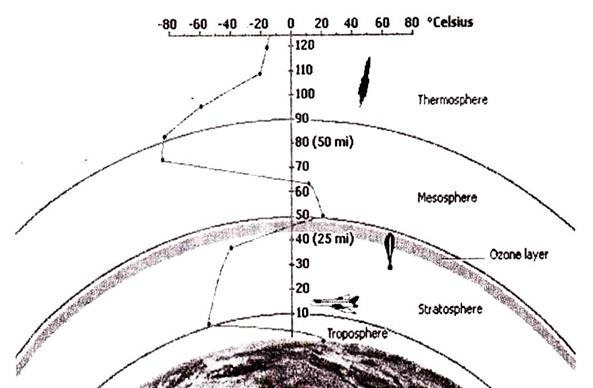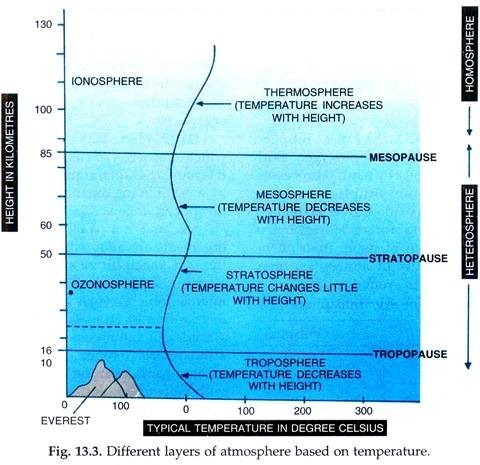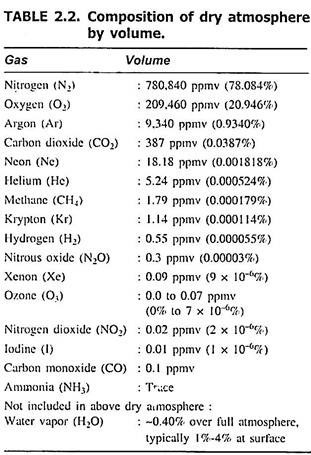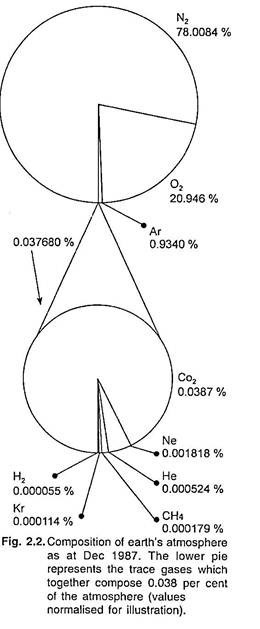Here is a compilation of essays on the ‘Atmosphere’ for class 6, 7, 8, 9, 10, 11 and 12. Find paragraphs, long and short essays on the ‘Atmosphere’ especially written for school and college students.
1. Essay on the Atmosphere:
An atmosphere (atmosphaera,) created in the 17th century from Greek atmos “Vapor” and sphaira “sphere” is a layer of gases that may surround a material body of sufficient mas and that is held in place by the gravity of the body.
Some planets consist mainly of various gases, but only their outer layer is their atmosphere.
Earth’s atmosphere, which contains oxygen used by most organisms for respiration and carbon dioxide used by plants, algae and cyanobacteria for photosynthesis, also protects living organisms from genetic damage by solar ultraviolet radiation. The oxygen so characteristic of our atmosphere was almost all produced by plants (cyanobacteria or, more colloquially, blue-green algae).
The present composition of the atmosphere is 79% nitrogen, 20% oxygen, and 1% other gases including carbon di oxide. The troposphere is where all weather takes place; it is the region of rising and falling packets of air. The air pressure at the top of the troposphere is only 10% of that at sea level 0.1 atmospheres.
The buffer zone between the troposphere and the next layer is called the tropopause. Just above the troposphere there is the stratosphere, where air flow is mostly horizontal. The thin ozone layer is present in the upper stratosphere zone that has a high concentration of ozone, a particularly reactive form of oxygen.
This ozone layer is primarily responsible for absorbing the ultraviolet radiation from the Sun. The formation of this layer is a delicate matter, since only when oxygen is produced in the atmosphere can an ozone layer formation. There is considerable recent concern that man-made fluorocarbon compounds may be depleting the ozone layer, with dire future consequences for life on the Earth.
The mesosphere is above the stratosphere and below the ionosphere (or thermosphere). In ionosphere many atoms are ionized, atoms either gained or lost electrons so they have a net electrical charge. The ionosphere is very thin and is also responsible for absorbing the most energetic photons from the Sun.
The structure of the ionosphere is strongly influenced by the charged particle wind from the Sun. An ore is a rock that contains a valuable or useful metal at a concentration high enough to make its mining a profitable operation.
2. Essay on the Atmosphere:
An atmosphere (from Greek atmos, ‘vapor’ + sphaira, ‘sphere’) or vapor-sphere is a layer of gases that surrounds the Earth and of sufficient mass for holding by the gravity. The atmosphere is one of the four spheres of the nature’s activities, the other three being hydrosphere, biosphere and geosphere.
Unlike the atmosphere in other planets, the presence of free oxygen, water vapor and carbon dioxide makes the Earth’s atmosphere a unique entity for the existence and survival of life on the planet. The characteristic properties of the atmosphere, such as, composition, temperature and pressure determine the weather and its long term version, the climate.
The temperature, the most significant factor, forms the basis of the division of five atmospheric layers. The five layers of the atmosphere have different densities, pressures, compositions and temperatures. The ozone layer in the stratosphere filters out harmful ultra violet rays from solar beam before it reaches to troposphere, the layer close to the Earth’s surface. The weather and climate are directly related to the conditions in the troposphere.
The two types of gases present in the atmosphere are termed as fixed and variable components. Fixed components consist of mainly nitrogen and oxygen and amount to 99% of the total atmospheric gases. The fixed components (99% of atmospheric gases) have little effect on weather and climate.
The variable components, constituting less than 1 percent of the atmospheric gases, have a much greater influence on both short-term weather and long-term climate. The minor gases, such as, water vapor, carbon dioxide, methane, nitrous oxide, and sulphur dioxide absorb heat (infra-red) emitted by solar beam and thus make the atmosphere warm. These gases are known as ‘greenhouse gases’.
However the increase in the atmospheric greenhouse gas content beyond that produced by natural cycles can lead to an increase in global temperature to higher level than that produced by natural process. The global warming beyond certain limits can cause drastic changes in the climatic conditions across the globe, with consequent disasters.
3. Essay on the Atmosphere:
Atmosphere is a mixture of different gases and it envelopes the earth all round. The air is an integral part of the earth’s mass and 99 per cent of the total mass of the atmosphere is confined to the height of 32 km from the earth’s surface.
Gaseous envelope surrounding the earth is called atmosphere. Several concentric layers can be identified in vertical profile of atmosphere. Density, temperature and composition differs in these layers. Near the earth’s surface, density is highest and with increase in altitude density decreases.
Atmosphere is a deep blanket of gases which envelope the earth. Air is a mechanical mixture of gases and cannot be felt except when it moves as wind. Total mass of the atmosphere has been calculated at about 56 x 1014 tonnes (t).
Without the atmosphere, there could be no clouds, winds or storms and weather. Air protects the earth from the full force of sun by day and prevents loss of too much heat at night. Therefore, without atmosphere life could not exist.
Starting from earth’s surface four concentric layers can be distinguished:
(i) Troposphere,
(ii) Stratosphere,
(iii) Mesosphere, and
(iv) Thermosphere (Fig. 13.3).
(i) Troposphere:
It extends up to altitude of 16 kilometres from the surface of the earth. Temperature decreases rapidly with increasing height in this layer.
(ii) Stratosphere:
It extends between altitudes of 16- 50 kilometres. Temperature increases with height in this layer. A layer of ozone called ozonosphere lies between altitudes of 25-50 kilometres.
It is an excellent region for air travel due to low moisture contents and absence of large convection currents.
(iii) Mesosphere:
It lies between altitudes of about 50-85 kilometres. Temperature decreases with height in this layer. Atmosphere’s minimum temperature is present m upper part of mesosphere.
(iv) Thermosphere:
It extends from an altitude of 85 kilometres upwards. In this layer temperature increases with height.
The outer extremely rarified fringe of the atmosphere is known as exosphere. It gradually merges with outer space.
Ionosphere has high quantity of ions and free electrons. They help in reflecting the radio waves signalled from surface of earth. Thus they help in long distance radio-communications. Satellites are stationed at different heights in thermosphere. INSAT-IB was launched from American Space Shuttle ‘Challenger’ in August 1983.
So, we have an exclusive satellite in geostationary orbit. It is the only operational satellite now in use around the world with a multipurpose capability; the others are all single purpose satellites. Air is being used as medium for aviation transport. It is main transmitting system for the communication of sound and human voice.
Homosphere extends up to 100 kms. from earth’s surface. It is homogenous due to air circulation in it.
Heterosphere represents the outer region of thermosphere and bears gases mixed with radioactive substances.
4. Essay on the Atmosphere:
Dry air is a mixture of gases with about 78 per cent of nitrogen, 21 per cent of oxygen and 0.94 per cent of argon by volume, and minute quantities of carbon dioxide, helium, neon, krypton, xenon oxides of nitrogen, hydrogen and ozone, and in some localities volatile organic matter, sulphurous gases and chlorine from volcanoes and other sources.
Water vapour is also a part of the atmosphere and is present to about 1.2 per cent of the total volume. Water vapour content depends on temperature and forms about 2.63 per cent at equator, 0.92 per cent at latitude 50° N and 0.22 per cent at latitude 70° N.
At some places the atmosphere may contain considerable amounts of fine earthy, salt crystals, smoke, soot, pollen, bacteria, volcanic dust, meteoric dust etc. spread as impurities to such an extent the sky may appear dark reducing visibility.
Dust present in the atmosphere increases red colours at dawn and twilight. Dust particles and minute salt crystals become nuclei around which water vapour condenses producing cloud particles of water or ice.
The earth has three great realms:
(i) Lithosphere (solids),
(ii) Hydrosphere (water) and
(iii) Atmosphere (gases).
The gaseous realm extends over the earth’s surface to a height of about 9,600 km and envelops it. It consists of several gases and minute suspended liquid and solid particles. Air is a mixture of several gases. Four gases: nitrogen, oxygen, argon and carbon dioxide account for more than 99 per cent of the dry air (Fig. 2.2 and Table 2.2).
5. Essay on the Atmosphere:
Earth’s atmosphere can be divided into five major layers (Fig. 2.3). These layers are mainly determined by whether temperature increases or decrease with altitude.
From lowest to highest, these major layers are:
1. Troposphere.
2. Stratosphere.
3. Mesosphere.
4. Thermosphere.
5. Exosphere.
1. Troposphere:
Troposphere begins at the surface and extends to between 7 km (23,000 ft) at the poles and 17 km (56,000 ft) at the equator, with some variation due to weather. Troposphere is mostly heated by transfer of energy from the surface, so on average the lowest part of the troposphere is warmest and temperature decreases with altitude.
This promotes vertical mixing (hence the origin of its name in the Greek word trope, meaning turn or overturn). Troposphere contains roughly 80 per cent of the mass of atmosphere. Tropopause is the boundary between troposphere and stratosphere.
2. Stratosphere:
Stratosphere extends from tropopause to about 51 km (32 mi; 170,000 ft). Temperature increases with height, which restricts turbulence and mixing. Stratopause, which is the boundary between stratosphere and mesosphere, typically is at 50 to 55 km (31 to 34 mi; 160,000 to 180,000 ft). Pressure here is 1/1000th sea level. Stratosphere contains much of the total ozone.
Air density is much less here, so that even limited absorption produces a large temperature increase. Temperature increases fairly, generally, with high in summer, with coolest air at equatorial tropopause. Stratosphere is thicker over poles and sometimes does not exist over the equator. Near its outer limit, stratosphere is the greatest concentration of ozone and rare nacreous clouds occasionally appear.
Ozone Layer:
Ozone layer is a layer in earth’s atmosphere which contains relatively high concentration of ozone (O3). This layer absorbs 93- 99 per cent of the son’s high frequency ultraviolet light, which is potentially damaging to life on earth. Over 91 per cent of ozone in earth’s atmosphere is present here.
It is mainly located in the lower portion of statosphere from around 10 to 50 km above earth, though the thickness varies seasonally and geographically. Ozone layer was discovered in 1913 by French Physicists Charles Fabry and Henri Buisson. Its properties were explored in detail by the British meteorologist GMB Dobson.
The photochemical mechanisms that give rise to ozone layer were discovered by British Physicist Sidney Chapman in 1930. Ozone in the stratosphere is created by ultraviolet light striking oxygen molecules containing two oxygen atoms (O2), splitting them into individual oxygen atoms (atomic oxygen); the atomic oxygen then combines with unbroken O2 to create ozone (O3).
where, M represents the energy and momentum balance provided by collision with a third atom or molecule.
Ozone molecule is also unstable (in stratosphere long-lived) and when ultraviolet light hits ozone, it splits into a molecule of O2 and an atom of atomic oxygen, a continuing process called the ozone – oxygen cycle, thus creating an ozone layer in the stratosphere, the region from about 10 to 50 km (32,000 to 164, 000 feet) above earth’s surface. Ozone concentrations are greatest between about 20 and 40 km, where they range from about 2 to 8 parts per million.
Although the concentration of ozone in the ozone layer is very small, it is vitally important to life because it absorbs biologically harmful ultraviolet (UV) radiation coming from sun. UV radiation is divided into three categories, based on its wavelength; these are referred to as UV-A (400-315 nm), UV-B (315-280 nm) and UV – C (280-100 nm).
UV-C, which would be very harmful to humans, is entirely screened out by ozone at around 35 km altitude. UV-B radiation can be harmful to skin and is the main cause of sunburn; excessive exposure can also causes genetic damage, resulting in problems such as skin cancer.
Ozone layer is very effective at screening out UV-B; for radiation with a wavelength of 290 nm, the intensity at the top of atmosphere is 350 million times stronger than at earth’s surface. Nevertheless, some UV-B reaches the surface. Most UV-A reaches the surface; this radiation is significantly less harmful, although it can potentially cause genetic damage.
3. Mesosphere:
Mesosphere extends from the stratopause to 80-85 km (50-53 mi; 260,000- 280,000 ft). It is the layer where most meteors burn up upon entering the atmosphere. Temperature decreases with height in the mesosphere. Mesopause, the temperature minimum that marks the top of the mesosphere, is the coldest place on earth and has an average temperature around -100°C (-148.0°F; 173.1°K).
4. Thermosphere:
Temperature increases with height in the thermosphere from mesopause up to thermopause, then is constant with height. Temperature of this layer can rises to 1,500°C (2.730°F), though the gas molecules are so far apart that temperature in the usual sense is not well defined.
International Space Station orbits in this layer, between 320 and 380 km (200 and 240 mi). Top of thermosphere is the bottom of exosphere, called the exobase. Its height varies with solar activity and ranges from about 350-800 km (220-500 mi; 1,100.000-2,600,000 ft).
5. Exosphere:
The outermost layer of earth’s atmosphere extends from exobase upward. Here the particles are so far apart that they can travel hundreds of km without colliding with one another. Since the particles rarely collide, atmosphere no longer behaves like a fluid. These free moving particles follow ballistic trajectories and may migrate into and out of magnetosphere or solar wind. Exosphere is mainly composed of hydrogen and helium.
Other Layers:
Within the five principal layers determined by temperature are several layers determined by other properties.
Ozone layer is contained within the stratosphere. In this layer ozone concentrations are about 2 to 8 parts per million (ppm), which is much higher than in lower atmosphere but still very small compared to the main components of atmosphere.
Ionosphere, part of atmosphere that is ionised by solar radiation, stretches from 50 to 1,000 km (31 to 620 mi; 160,000 to 3,300,000 ft) and typically overlaps both exosphere and thermosphere. It forms the inner edge of magnetosphere. It has practical importance because it influences, for example, radio propagation on the earth. It is responsible for auroras.
Homosphere and heterosphere are defined by whether the atmospheric gases are well mixed. In the homosphere, chemical composition of atmosphere does not depend on molecular weight because gases are mixed by turbulence. Homosphere includes troposphere, stratosphere and mesosphere. Above turbopause at about 100 km (62 mi; 330,000 ft), essentially corresponding to mesopause, the composition varies with altitude.
This is because the distance that particles can move without colliding with one another is large compared with size of motions that cause mixing. This allows the gases to stratify by molecular weight, with the heavier ones such as oxygen and nitrogen present only near the bottom of heterosphere. Upper part of heterosphere is composed almost completely of hydrogen, the lightest element.
Planetary boundary layer is part of troposphere that is nearest to earth’s surface and is directly affected by it, mainly through turbulent diffusion. During the day the planetary boundary layer usually is well mixed, while at night it becomes stably stratified with weak or intermittent mixing. Depth of planetary boundary layer ranges from as little as about 100 m on clear, calm nights to 3000 m or more during afternoon in dry regions.
Average temperature of the atmosphere at the surface of earth is 14°C (57°F; 287°K) or 15°C (59°F: 288° K), depending on the reference.
6. Essay on the Atmosphere:
1. Earth’s surface is dominated by nitrogen and oxygen contributing 78% and 20.9% respectively. Rest of 1% is contributed by argon 0.93% and CO2 0.03% along with hydrogen, helium, neon, krypton and many other gases in minute quantities.
2. Small amount of water vapours, dust, salts, smoke is also found.
3. Movement of air up to height of 100 kms occurs largely and is responsible for mixing up and making the atmosphere homogeneous.
4. Particular climatic conditions and water cycle in an area is controlled by general circulation of air.
5. Troposphere is peculiar in the sense that it contains much of air.
6. Atmosphere provides oxygen, carbon dioxide and nitrogen to living beings.
7. Ozone layer is in the stratosphere. Ozone is produced in the stratosphere by the action of high energy UV radiations. Oxygen being a good absorber of UV radiation, its presence there effectively blocks out sun’s ultra-violet radiations.
8. The stratospheric ozone layer, thus plays an important protective role for life on earth. It has been estimated that one per cent drop in ozone level in the stratosphere could cause 10,000 more cases of skin cancer a year in DBA alone. Ozone is an allotropic form of oxygen containing three atoms per molecule rather than two as in the case of common oxygen.
9. There are several gaseous chemicals as nitrogen oxide and methane, which can destroy oxygen. Both these gases are produced in plenty by natural processes.
10. Lightning and volcanic eruptions release enormous quantities of nitrogen oxide. Ozone has highest concentration 25 kms over earth’s surface. However, it is never more than one millionth of main atmosphere. Much change in ozone quantity of atmosphere may cause bad effects on life on earth around.





